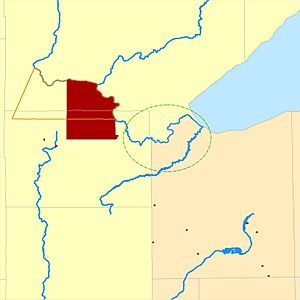Fond du Lac Indian Reservation facts for kids
The Fond du Lac Indian Reservation is a special area of land in northern Minnesota. Its name in the Ojibwe language is Nah-Gah-Chi-Wa-Nong, which means "Where the current is blocked." This reservation is the home of the Fond du Lac Band of Lake Superior Chippewa.
It is located near the city of Cloquet in Carlton and Saint Louis counties. The tribe also owns land in Douglas County, Wisconsin. Before this reservation was created, the Fond du Lac Band lived closer to Lake Superior and the Saint Louis River, where Duluth is now.
Contents
History of the Fond du Lac Reservation
Early Land Agreements and Treaties
The Fond du Lac tribe, along with other Ojibwa bands, agreed to give up some of their land to the United States in a treaty in 1837. This land was mostly in central Minnesota and northern Wisconsin.
Later, in 1842, as part of the Treaty of La Pointe, the Fond du Lac Band and other Ojibwa tribes gave up even more land. This land was mainly around Lake Superior in Wisconsin and the western part of Michigan's Upper Peninsula.
In 1854, another treaty, the 1854 treaty, led to the tribe giving up more land to the U.S. government.
Creating the Reservation
Under the 1854 treaty, the U.S. government set up the Fond du Lac Indian Reservation where it is today. This new location was further up the Saint Louis River. The first reservation was actually bigger than it is now.
During the treaty talks, U.S. representatives promised to include Perch and Big lakes in the reservation. However, these lakes were not included at first. The tribe asked for the lakes to be added. The U.S. agreed to include them, but in return, the tribe had to accept a smaller western border for the reservation.
Helping During the Sioux Uprising
On September 2, 1862, the Fond du Lac St. Louis Reservation sent a letter to Governor Alexander Ramsey. Chief Naw-Gaw-Nub and Chief Shin-Gwack asked the Governor to tell President Lincoln that the Fond du Lac Chippewa wanted to help during the Sioux Uprising.
Changes to Land Ownership
Later, laws like the Dawes Act of 1887 and the Nelson Act of 1889 caused problems for the reservation. These laws divided tribal land into smaller pieces for individual tribal members. Much of this land was then sold to non-Native settlers and logging companies.
By 1934, almost three-quarters of the Fond du Lac reservation land was owned by non-Native people. The tribe started buying back land after the Indian Reorganization Act of 1934. By 1981, they had regained control of more than half of the land within the reservation.
Geography of the Reservation
The Fond du Lac Reservation and its trust lands cover about 159 square miles (412 square kilometers). Most of this area is land, with a smaller part being water.
People of the Fond du Lac Reservation
In 2020, about 4,184 people lived on the Fond du Lac Reservation and its trust lands. About half of the people living there were White, and about 40% were Native American.
There are many non-Native people living on the reservation. This is because of the historical laws that allowed reservation lands to be sold in the early 1900s.
Economy and Businesses
The Fond du Lac tribe owns several businesses that help the community. They own two casinos:
- Black Bear Casino (which also has a golf course) in Carlton, Minnesota
- Fond-du-Luth-Casino in Duluth
The tribe also owns other businesses, including:
- Northwoods Radio
- FDL Gas & Grocery
- FDL Propane
- FDL Sand & Gravel
Communities on the Reservation
Several communities are located within or partly within the Fond du Lac Reservation:
Townships in the Area
Parts of these townships are also within the reservation:
- Arrowhead Township
- Brevator Township
- Brookston (city)
- Cloquet (city)
- Culver Township
- North Carlton unorganized territory
- Perch Lake Township
- Stoney Brook Township
- Twin Lakes Township
Notable People from Fond du Lac
- Jim Northrup, a well-known columnist and writer.
See also
 In Spanish: Reserva india de Fond du Lac para niños
In Spanish: Reserva india de Fond du Lac para niños



